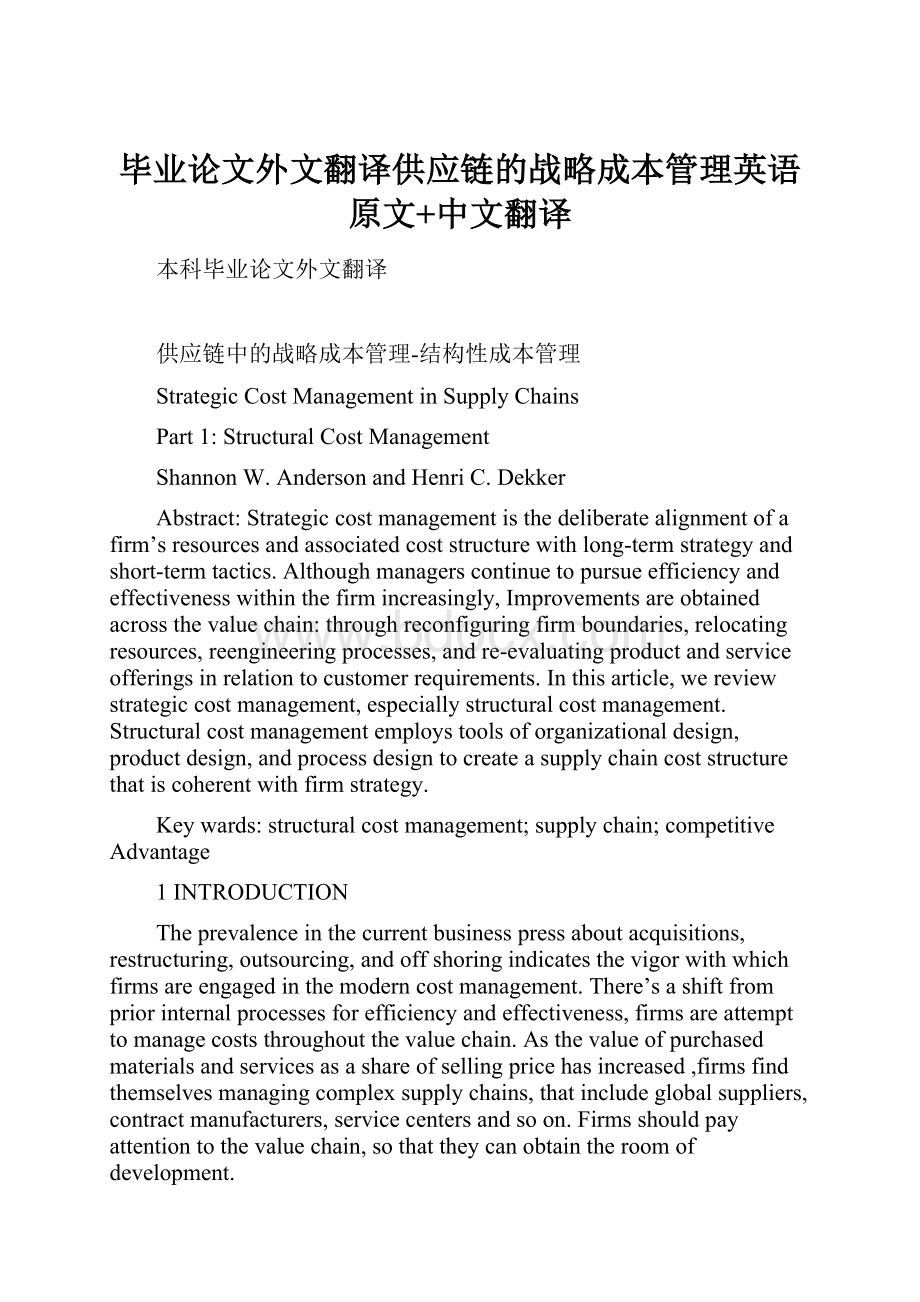毕业论文外文翻译供应链的战略成本管理英语原文+中文翻译.docx
《毕业论文外文翻译供应链的战略成本管理英语原文+中文翻译.docx》由会员分享,可在线阅读,更多相关《毕业论文外文翻译供应链的战略成本管理英语原文+中文翻译.docx(11页珍藏版)》请在冰豆网上搜索。

毕业论文外文翻译供应链的战略成本管理英语原文+中文翻译
本科毕业论文外文翻译
供应链中的战略成本管理-结构性成本管理
StrategicCostManagementinSupplyChains
Part1:
StructuralCostManagement
ShannonW.AndersonandHenriC.Dekker
Abstract:
Strategiccostmanagementisthedeliberatealignmentofafirm’sresourcesandassociatedcoststructurewithlong-termstrategyandshort-termtactics.Althoughmanagerscontinuetopursueefficiencyandeffectivenesswithinthefirmincreasingly,Improvementsareobtainedacrossthevaluechain:
throughreconfiguringfirmboundaries,relocatingresources,reengineeringprocesses,andre-evaluatingproductandserviceofferingsinrelationtocustomerrequirements.Inthisarticle,wereviewstrategiccostmanagement,especiallystructuralcostmanagement.Structuralcostmanagementemploystoolsoforganizationaldesign,productdesign,andprocessdesigntocreateasupplychaincoststructurethatiscoherentwithfirmstrategy.
Keywards:
structuralcostmanagement;supplychain;competitiveAdvantage
1INTRODUCTION
Theprevalenceinthecurrentbusinesspressaboutacquisitions,restructuring,outsourcing,andoffshoringindicatesthevigorwithwhichfirmsareengagedinthemoderncostmanagement.There’sashiftfrompriorinternalprocessesforefficiencyandeffectiveness,firmsareattempttomanagecoststhroughoutthevaluechain.Asthevalueofpurchasedmaterialsandservicesasashareofsellingpricehasincreased,firmsfindthemselvesmanagingcomplexsupplychains,thatincludeglobalsuppliers,contractmanufacturers,servicecentersandsoon.Firmsshouldpayattentiontothevaluechain,sothattheycanobtaintheroomofdevelopment.
2STRATEGICCOSTMANAGEMENT
Costmanagementresearchhastendedtofallintotworelatedstreams.Thefirstresearchstreamexaminewhetherandhowfirmsconfigureaccountingdatatosupportvaluechainanalysis;Thesecondresearchstreamattempttoderivetherelationshipbetweenafirm’sstrategyandcoststructure.Thefocusisonthecausalrelationbetweenactivitylevelsandtheresourcesthatarerequired.Theseresearchstreamstakeasgiventhefirm’sstrategyandstructureandfocusonwhetheraccountingrecordsarecapableofreflectingordetectingtheeconomicsofthechosenstrategy.InthisreviewwetakeShank’sbroaderperspectivethatmuchofwhatconstitutesstrategiccostmanagementisfoundinchoicesaboutorganizationalstrategyandstructure.FollowingAnderson,wedefine“strategiccostmanagement”asdeliberatedecisionmakingaimedataligningthefirm’scoststructurewithitsstrategyandwithmanagingtheenactmentofthestrategy.
Wefocusoninteractionsacrossfirmboundaries;Specially,thebuyer/supplierinterface,asasourceofcompetitiveadvantagethatcandeliverlowcost,aswellashighproductivity,quality,customerresponsiveness,andinnovation.Shankpositedthattwotypesofcostdriversarethebasisforstrategiccostmanagement:
structuralcostdriversthatreflectorganizationalstructure,investmentdecisions,andtheoperatingleverageofthefirmandexecutivecostdriversthatreflecttheefficiencyofexecutingthestrategy.Stateddifferently,structuralcostmanagementmaybeconceivedofasachoiceamongalternativeproductionfunctionsthatusedifferentinputsorcombinationsthereoftomeetaparticularmarketdemand.Executivecostmanagementisconcernedinsteadwithwhether,foragivenproductionfunction,thefirmisontheefficientfrontier.Structuralandexecutivecostmanagementisconnectedthroughimprovementactivities.Forexample,costdriveranalysisisacatalystforefficiencyimprovementsofexistingprocessesandforreengineeringprocessestocreateadifferentcoststructure.Clearly,costmanagementisonlyapartoflongtermprofitmaximization.Thispaperserieswillnotdiscussstrategicrevenuemanagement;however,weacknowledgeinterdependenciesbetweencostsandrevenuesassociatedstructuralcostmanagementandtheexecutivecostmanagementactivitiesofthesustainabilityofthestrategy.Oftenthegreatestopportunitiesforstrategiccostmanagementcrossfirmboundaries.Shankadvocatedcostmanagementacrossthevaluechain,andotheraccountingscholarshavecalledforresearchonhowaccountingfacilitatesmoderninter-organizationalrelationships.
3STRUCTURALCOSTMANAGEMENTINSUPPLYCHAINS
Shankarguedthatstructuralcostdriversassociatedwithorganizationalstructure,investmentdecisions,andtheoperatingleverageofthefirm.Insupplychainmanagement,structuralcostmanagementincludesthedecisiontoseekanexternalsupplier,selectingoneormoreexternalsuppliers,anddesigningthebuyer/supplierrelationship.Theseelementsofsupplychainmanagementareimportantdeterminantsofcoststructureandarecentraltomanagingriskinsupplyrelations.Supplierselectionprocessesareakintopersonnelcontrolswithinthefirmthatensurethefitnessbetweenemployeeskillsandjobrequirements.Designingthebuyer/supplierrelationshipencompassesformalcontractualmanagementcontrolssuchasspecifyingauthorityforsupplydecisions,performancerequirements,andrewardsorsanctionsfornonperformance,aswellasformalandinformalcontrolsthatreinforcedesiredculturalnorms.Althoughwefocusonstructuralcostmanagement,manyofthecostmanagementdecisionsdiscussedinthissectionrelatetobalancingthe“costofcontrol”againstrisksofinter-firmtransactions.Wereviewresearchandcontemporarypracticesassociatedwithsourcingdecisions,supplierselectioninthesectionsthatfollow.
4SOURCING:
MAKE;BUYORALLY
Acorecomponentofstructuralcostmanagementisthedecisiontoexecuteactivitieswithinthefirmortooutsourcethemtoanotherparty.Theso-called“make-buy-or-ally”decisionconsidershowandwhereinthevaluechainfirmsdrawtheirorganizationalboundariesandwhichactivitiesareconductedinsideversusoutsidethefirm.Althoughthebuyerandsupplierareseparatefirms,thesupplyrelationshipoftenincludescollaborationintheuncertainrealmofproductandprocessdesign.
Transactioncosteconomicsisthemostwidelyusedframeworkforexplainingfirmboundaryandorganizationaldesignchoices.Productioncostsaredefinedbyproductiontechnologyandefficiency.Abuyerandsupplier’sproductioncostsmaydifferiftheyusedifferenttechnology,operateatdifferentscales,oroperatewithdifferentefficiencyAbuyer’scostaccountingrecordsmaybeonebasisforcomparingthe“make”optionwithpricesofexternalsuppliers.Transactioncostsconcernsaboutopportunismassociatedwithfirm’stransactions.Examplesoftransactioncostsincludecostsofactivitiessuchassearchingforpartners,negotiatingandwritingcontracts,monitoringandenforcingcontractcompliance.Transactioncostsarenottypicallyaccessibleand,inthecaseofopportunitycosts,maynotevenbeincludedincostaccountingrecords.Consequently,textstypicallywarnstudentstoconsiderstrategicfactorsbeforemakingasourcingdecisionbasedonlyonproductioncosts.Thisisoneareawherecostmanagementpractices,bothmeasurementandanalysis,canbeimprovedtobettersupportstructuralcostmanagementdecisionsassociatedwithsourcing.
5INTERDEPENDENCEINSUPPLYCHAINS
Althoughwediscussthesourcingdecisionasalogical“startingpoint”insupplychainmanagement,inrealitythiselementofstructuralcostmanagementisintertwinedwithotherelementsofstrategiccostmanagement.Forexample,inTCEtheory,sourcingdecisionsarepositedtoreflecttheminimizationofanticipatedexchangehazards.Thepotentialtransactionpartnersareimportantpredictorsofexchangehazards.However,incomplexsupplychainsinwhichmanysupplierscontributetothecompletedproduct,productarchitectureisalsoakeydeterminantofsourcingdecisions.The“partnership”strategiesinsupplychainsdependcriticallyonusingcriteriaotherthanpriceinsupplierselection.Thus,structuralcostmanagementdecisionsassociatedwithsourcingareintertwinedwithstructuralcostmanagementpracticesinsupplierselection.
6THESUPPLYCHAINSASASOURCEOFCOMPETITIVEADVANTAGE
TCE,withitsunderlyingperformanceriskandrelationalrisk,focusesonpotentialdownsides
ofcooperation.Anotherschoolofthought,theresource-basedviewRBVofthefirm,focusesontheupsideofcooperation.TheRBVimplicatesinter-firmcooperationintherealizationofstrategicadvantage,withfirmboundariesresultingfrommanagers’dynamicsearchforopportunitiestodeployvaluable,scarce,inimitableresourcestoobtainabnormalreturns.Thebasisforexchangeinalliancescanbefinancial,technological,physical,ormanagerialresources.StudiesapplyingtheRBVtoexplainfirmboundariesemphasizetheinimitablevalueofcollaborativepartnerships.
WhiletheperspectivesofTCEandriskmanagementdifferfromtheRBV,bothassumethatfirmchoicesaremotivatedbythegoalofmaximizinglong-runperformance.WhereasTCEfocusesonminimizingtransactioncostsatagiventime,theRBVemphasizestheilliquidityandimmobilityofvaluableresources.Thisapproachadmitsthepossibilitythattransactingwithexternalpartiesdynamicallychangestheresourcesandcapabilitiesthatwillbeavailableinfutureperiods.Togethertheseframeworkspointtoimportantareasforgrowthinmanagementaccounting,Specifically,TCEandriskmanagementindicatetheimportanceofmeasuringriskinsupplyrelationshipsandformallyintegratingriskassessmentsintothemake,buy,orallydecision.TheRBVindicatestheimportanceoftheemergingareaofaccountingforhumancapitalandotherfirmcapabilitiesandintangibleassetswhosevaluechangesthroughexchangewithstrategicsupplypartners.
7TRENDSINSUPPLYCHAINGROWTH
Recentyearshav